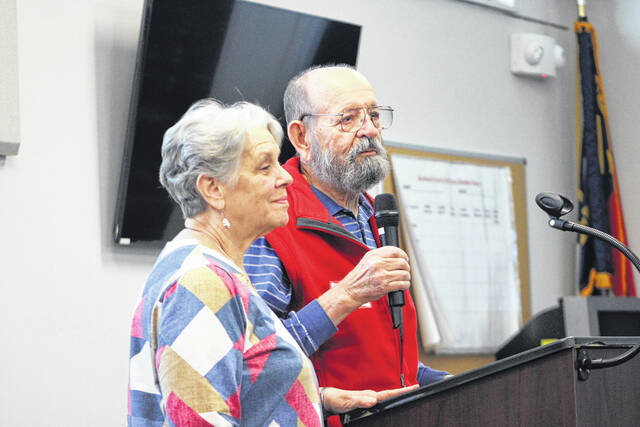
With the help of his wife Betty, Larry Barnett shares his story Monday of surviving a cardiac arrest at the annual Randomized Cluster Evaluation of Cardiac Arrest Systems (RACE-CARS) Trial held at the Scotland Emergency Operations Center.
Tomeka Sinclair | The Laurinburg Exchange
LAURINBURG — On Dec. 8, 2022, Larry Barnett went into cardiac arrest just after delivering a speech at a retirement dinner in Downtown Laurinburg.
“I remember coming down off the stage and I’d had Parkinson’s for four or five years now so I don’t get around well anymore and when I stepped off the stage I was a little shaky … I sat down at the table and said ‘Betty, I’m not really feeling well’ and that’s all I remember,” Barnett said.
Barnett was lucky. The event he spoke at was attended by several retired first responders who were able to immediately begin administering CPR.
“Scotland County EMS had an awesome response time with about three or four minutes,” said Matt Locklear, assistant director of Scotland’s EMS.
During the ride to the hospital, Barnett was defibrillated and CPR continued.
“The fire department was dispatched, there were a lot of moving parts on that cardiac arrest event,” Locklear said. “Once he arrived at the hospital our flight crew at Cape Fear Valley was able to airlift Mr. Barnett to Moore Regional … Essentially, all of those moving parts saved his life.”
Barnett is alive today to tell what he remembers of the story but many aren’t so lucky.
This is why Scotland County is among the counties in North Carolina participating in the Randomized Cluster Evaluation of Cardiac Arrest Systems (RACE-CARS) Trial, a trial led by a Duke Clinical Research Team, that tests the implementation of community interventions to improve the survival rate for people with cardiac arrest, one of the main causes of death in North Carolina.
”So that means we’re working intensively with your emergency medical services, 911 dispatch, first responders, community educators to optimize what you’re doing in the community to respond to people who’ve had cardiac arrest,” said Chris Granger, a member of the Duke Clinical Research Institute.
On Monday, an annual RACE-CARS meeting was held at the Scotland County Emergency Operations Center with stakeholders to review and share data and highlight accomplishments within our county that prove Scotland County is committed to improving survival rates with good quality out-of-hospital outcomes.
During the meeting, Larry Barnett, with the help of his wife Betty, shared his survivor story.
“I was there when that happened and saw them working on you … It looked like something off TV the way they were working on you … They worked on you and I’m glad you survived,” said Dorothy Tyson, Scotland’s Community liaison.
Granger said the care Barnett received was commendable but many people throughout rural communities are not as fortunate to be surrounded by people in the medical industry when they are in these situations.
In 2019, in North Carolina, about 9,000 people suffered a non-traumatic out-of-hospital cardiac arrest.
To combat these numbers in Scotland, EMS has worked and fundraised to sponsor CPR training and get more automated external defibrillators (AEDs) in more hands throughout the county. An AED is a medical device designed to analyze the heart rhythm and deliver an electric shock to victims of ventricular fibrillation to restore the heart rhythm to normal.
“All of our fire departments have AEDs now,” Locklear said. “They have them on their fire apparatuses and they’re responding to cardiac arrests. Prior to about four years ago, our fire departments didn’t respond to cardiac- they had AEDs but they weren’t being dispatched along with us to save a cardiac arrest.”
The results of these efforts have been Scotland County improving bystander CPR rates by 80% in the third quarter of the year 2023.
Locklear said the goal is to continue increasing the number of AEDs available in the community, purchasing hands-free CPR devices, continuing to increase the number of people with hands-on CPR training as well as increasing the survival rate with good neurological functions.
One way EMS is getting more AEDs in the community is by building partnerships with the faith community.
“Most of the calls we got on Sunday were at churches … Whether it be a diabetic emergency or a cardiac arrest, a lot of them were at churches,” Locklear said.
On the dispatch side, Scotland’s dispatch’s recognition for the need for CPR tops other counties. A total of 75% of the time CPR started in under 180 seconds, according to Scotland Emergency Communications assistant director Jonathan Lemmond. Scotland is also ranked number 1 in the state at the time of the call to the first compression.
Lemmond credits the success to hands-on training but also the department’s drive to be the “best version of themselves.”
“We have a bunch of motivated employees,” Lemmond said.
Tomeka Sinclair can be reached at tsinclair@laurinburgexch.wpenginepowered.com.

